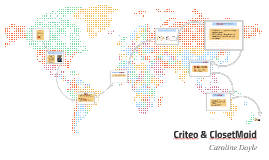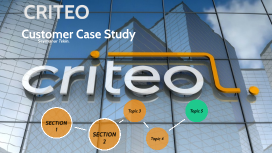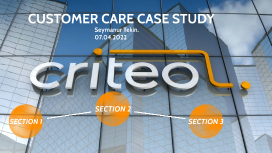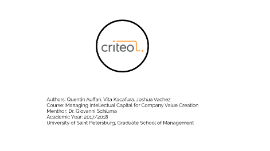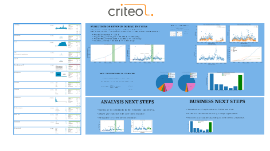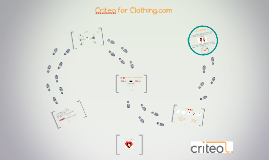Criteo Presentation
Transcript: CRITEO Unveiling Criteo: An AdTech Leader How Criteo Provides Value – Value Creation & Capture Value Creation: Criteo helps advertisers and retailers deliver personalized ads using real-time data, AI, and machine learning. Enables better targeting and higher conversion rates through first-party data and commerce insights. Supports omnichannel campaigns: display, video, native, and connected TV ads. Value Capture: Revenue from performance-based advertising (Cost Per Click/Action). Long-term partnerships with advertisers, agencies, and retailers. Monetizes its AI-powered Commerce Media Platform. Digital Ecosystem & Strategic Position THANK YOU FOR YOUR ATTENTION !!!!!!! :)) Digital Ecosystem: Integrates with over 20,000 advertisers and thousands of publishers. Commerce Grid, Retail Media, and Audience solutions. Works with 1st-party data, adapting to cookie-less future (e.g., Criteo ID, Unified ID 2.0). Strategic Positioning: Competing with Google, Meta, and Amazon in commerce media. Strong focus on transparency, open internet, and privacy-friendly solutions. Criteo’s Business Model Model Type: B2B, AdTech Platform Key Components: Advertisers: Use Criteo’s tools for targeting and retargeting. Retailers & Publishers: Monetize their inventory via Criteo's demand. Commerce Media Platform: Connects demand (advertisers) with supply (publishers/retailers) using commerce data. Revenue Model: Performance-based , subscription and platform fees (in some solutions), and increasing SaaS components. Visual Idea: A platform diagram connecting advertisers ↔ Criteo ↔ retailers & publishers, powered by AI and data. Exploring Value Creation, Capture, and Strategic Position in AdTech Value Capture Strategies at Criteo Revenue Generation Models Long-Term Partnerships Criteo employs diverse revenue generation models, including performance-based advertising, subscription fees, and platform fees for services. This multifaceted approach allows Criteo to scale its revenue streams while aligning its incentives with client success. Criteo places significant value on establishing long-term partnerships with advertisers, agencies, and retailers, which are critical for sustaining growth. These partnerships allow for collaborative strategies that enhance advertising effectiveness and drive increased revenue. Performance-Based Advertising Monetization of Commerce Media Platform Criteo focuses on performance-based advertising, primarily utilizing Cost Per Click (CPC) and Cost Per Action (CPA) models. These models ensure that advertisers pay only for measurable results, fostering a mutually beneficial relationship between Criteo and its clients. Criteo’s Commerce Media Platform is central to its monetization strategy, utilizing AI-driven insights to match advertisers with relevant retailers effectively. As Criteo continues to optimize this platform, it's positioned to capture a larger share of the digital advertising market. Creating Value Through Innovative Advertising Aryan Moradpour Rania Messaoudi Mohamed Lachguer Ghita Zougar Real-Time Data Utilization Personalized Advertising Criteo's platform utilizes real-time data to make instant advertising decisions. This capability allows advertisers to respond quickly to market changes and optimize campaigns for maximum impact, enhancing overall ad spend efficiency. Criteo's personalized advertising tailors ad experiences based on consumer behavior and preferences. By utilizing first-party data, the platform delivers relevant ads to the right audience, significantly increasing response rates and fostering brand loyalty. Omnichannel Campaign Support AI and Machine Learning Integration Criteo supports omnichannel campaigns across various platforms, including display, video, and connected TV ads. This unified approach ensures consistent messaging and engagement, enhancing customer experience and driving conversions across channels. Through AI and machine learning, Criteo optimizes ad delivery and targeting precision. These technologies analyze vast amounts of consumer data, identifying trends and predicting future behaviors to maximize ad effectiveness. Criteo's Business Model and Digital Ecosystem B2B AdTech Platform Structure Key Components: Advertisers, Retailers, Publishers Criteo's platform functions as a B2B ecosystem that facilitates interactions between advertisers and publishers, optimizing ad placements based on deep data insights. Its architecture leverages AI and machine learning to enhance targeted advertising and improve campaign effectiveness across various digital environments. Criteo connects thousands of advertisers with retailers and publishers, creating a dynamic marketplace for ad inventory. Advertisers utilize Criteo's advanced targeting tools while retailers and publishers monetize their platforms through demand generated by Criteo's network, ensuring mutual benefits across the ecosystem. Integration with 1st-Party Data and Privacy Measures Strategic Positioning in the Market






